Associations of Fluid Overload
VerifiedAdded on 2022/09/01
|15
|5278
|18
AI Summary
Contribute Materials
Your contribution can guide someone’s learning journey. Share your
documents today.
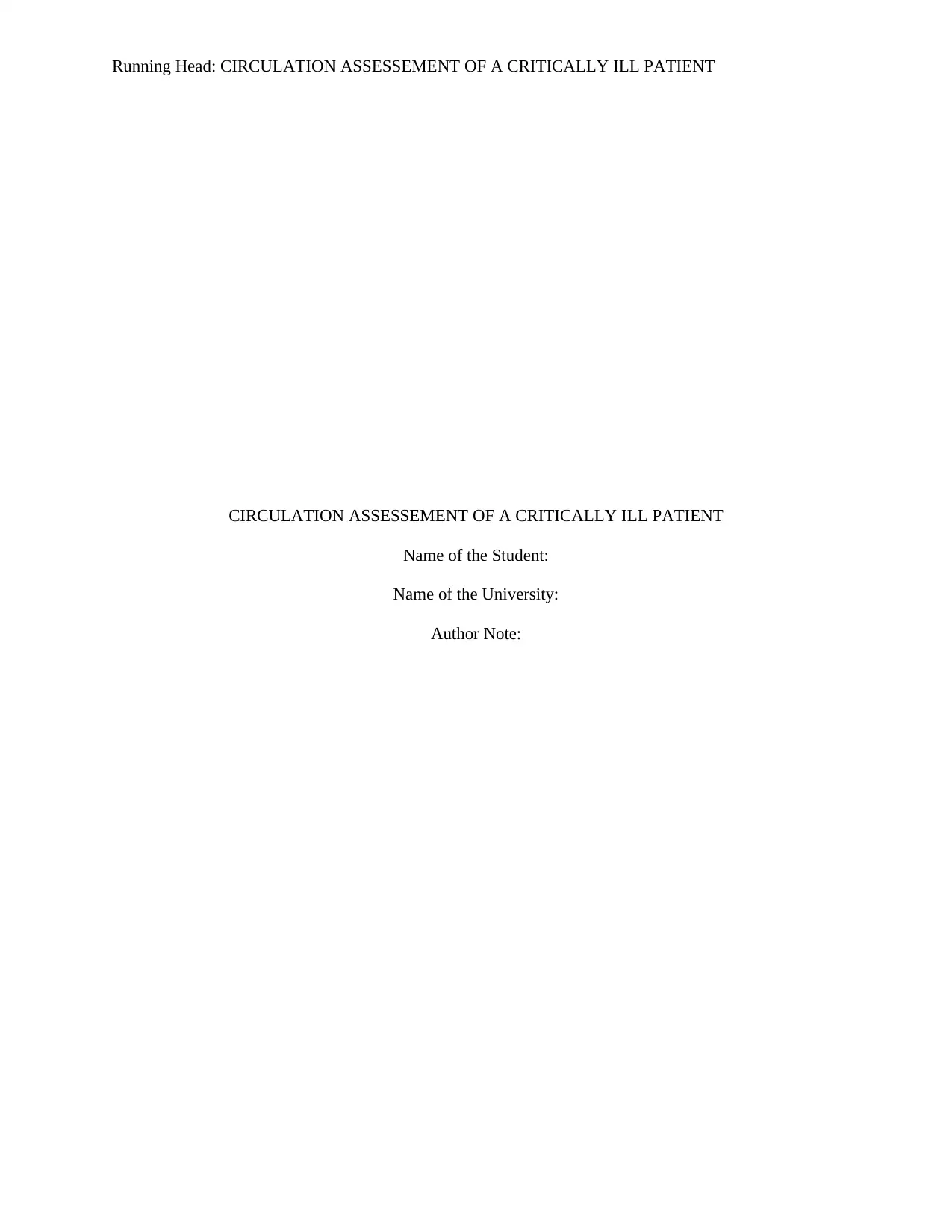
Running Head: CIRCULATION ASSESSEMENT OF A CRITICALLY ILL PATIENT
CIRCULATION ASSESSEMENT OF A CRITICALLY ILL PATIENT
Name of the Student:
Name of the University:
Author Note:
CIRCULATION ASSESSEMENT OF A CRITICALLY ILL PATIENT
Name of the Student:
Name of the University:
Author Note:
Secure Best Marks with AI Grader
Need help grading? Try our AI Grader for instant feedback on your assignments.
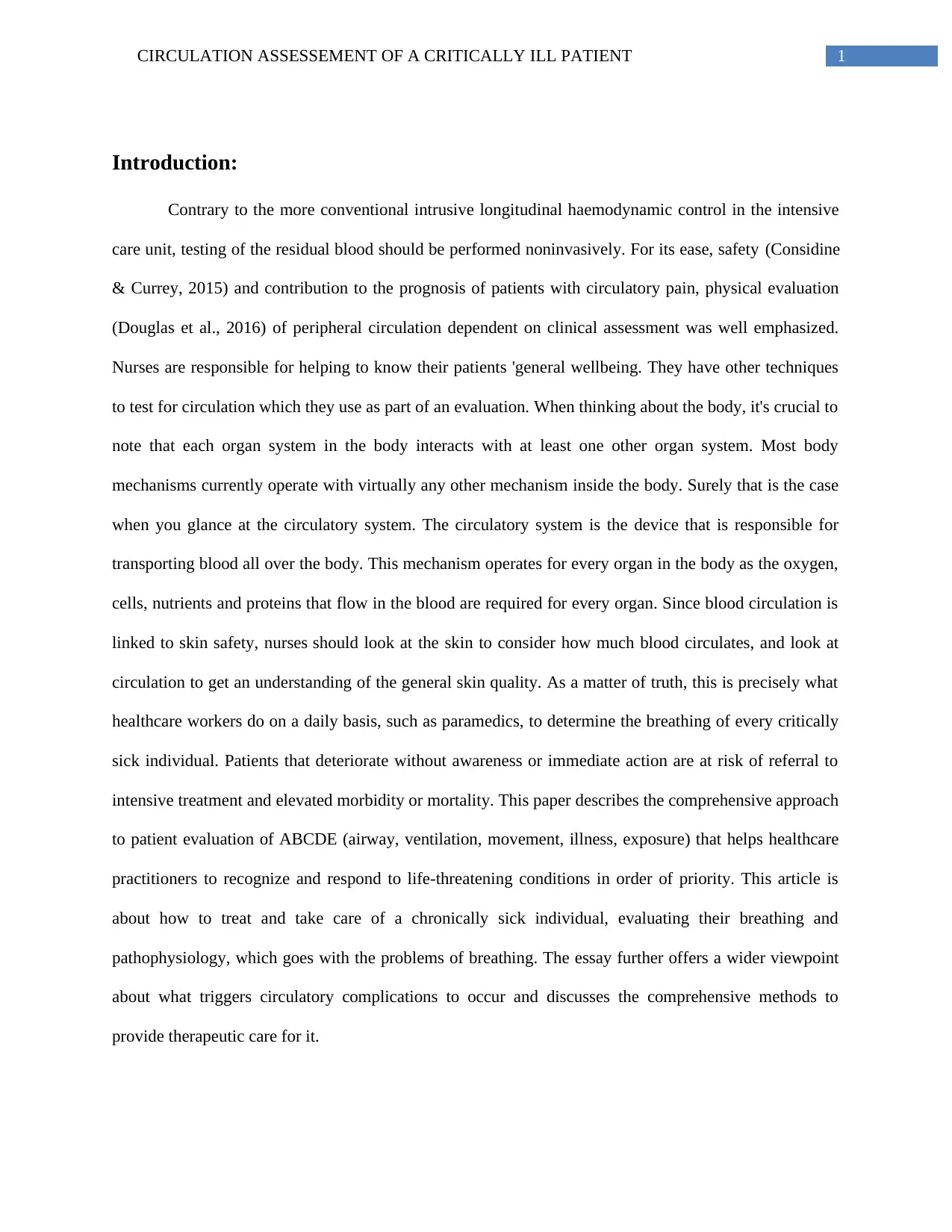
1CIRCULATION ASSESSEMENT OF A CRITICALLY ILL PATIENT
Introduction:
Contrary to the more conventional intrusive longitudinal haemodynamic control in the intensive
care unit, testing of the residual blood should be performed noninvasively. For its ease, safety (Considine
& Currey, 2015) and contribution to the prognosis of patients with circulatory pain, physical evaluation
(Douglas et al., 2016) of peripheral circulation dependent on clinical assessment was well emphasized.
Nurses are responsible for helping to know their patients 'general wellbeing. They have other techniques
to test for circulation which they use as part of an evaluation. When thinking about the body, it's crucial to
note that each organ system in the body interacts with at least one other organ system. Most body
mechanisms currently operate with virtually any other mechanism inside the body. Surely that is the case
when you glance at the circulatory system. The circulatory system is the device that is responsible for
transporting blood all over the body. This mechanism operates for every organ in the body as the oxygen,
cells, nutrients and proteins that flow in the blood are required for every organ. Since blood circulation is
linked to skin safety, nurses should look at the skin to consider how much blood circulates, and look at
circulation to get an understanding of the general skin quality. As a matter of truth, this is precisely what
healthcare workers do on a daily basis, such as paramedics, to determine the breathing of every critically
sick individual. Patients that deteriorate without awareness or immediate action are at risk of referral to
intensive treatment and elevated morbidity or mortality. This paper describes the comprehensive approach
to patient evaluation of ABCDE (airway, ventilation, movement, illness, exposure) that helps healthcare
practitioners to recognize and respond to life-threatening conditions in order of priority. This article is
about how to treat and take care of a chronically sick individual, evaluating their breathing and
pathophysiology, which goes with the problems of breathing. The essay further offers a wider viewpoint
about what triggers circulatory complications to occur and discusses the comprehensive methods to
provide therapeutic care for it.
Introduction:
Contrary to the more conventional intrusive longitudinal haemodynamic control in the intensive
care unit, testing of the residual blood should be performed noninvasively. For its ease, safety (Considine
& Currey, 2015) and contribution to the prognosis of patients with circulatory pain, physical evaluation
(Douglas et al., 2016) of peripheral circulation dependent on clinical assessment was well emphasized.
Nurses are responsible for helping to know their patients 'general wellbeing. They have other techniques
to test for circulation which they use as part of an evaluation. When thinking about the body, it's crucial to
note that each organ system in the body interacts with at least one other organ system. Most body
mechanisms currently operate with virtually any other mechanism inside the body. Surely that is the case
when you glance at the circulatory system. The circulatory system is the device that is responsible for
transporting blood all over the body. This mechanism operates for every organ in the body as the oxygen,
cells, nutrients and proteins that flow in the blood are required for every organ. Since blood circulation is
linked to skin safety, nurses should look at the skin to consider how much blood circulates, and look at
circulation to get an understanding of the general skin quality. As a matter of truth, this is precisely what
healthcare workers do on a daily basis, such as paramedics, to determine the breathing of every critically
sick individual. Patients that deteriorate without awareness or immediate action are at risk of referral to
intensive treatment and elevated morbidity or mortality. This paper describes the comprehensive approach
to patient evaluation of ABCDE (airway, ventilation, movement, illness, exposure) that helps healthcare
practitioners to recognize and respond to life-threatening conditions in order of priority. This article is
about how to treat and take care of a chronically sick individual, evaluating their breathing and
pathophysiology, which goes with the problems of breathing. The essay further offers a wider viewpoint
about what triggers circulatory complications to occur and discusses the comprehensive methods to
provide therapeutic care for it.
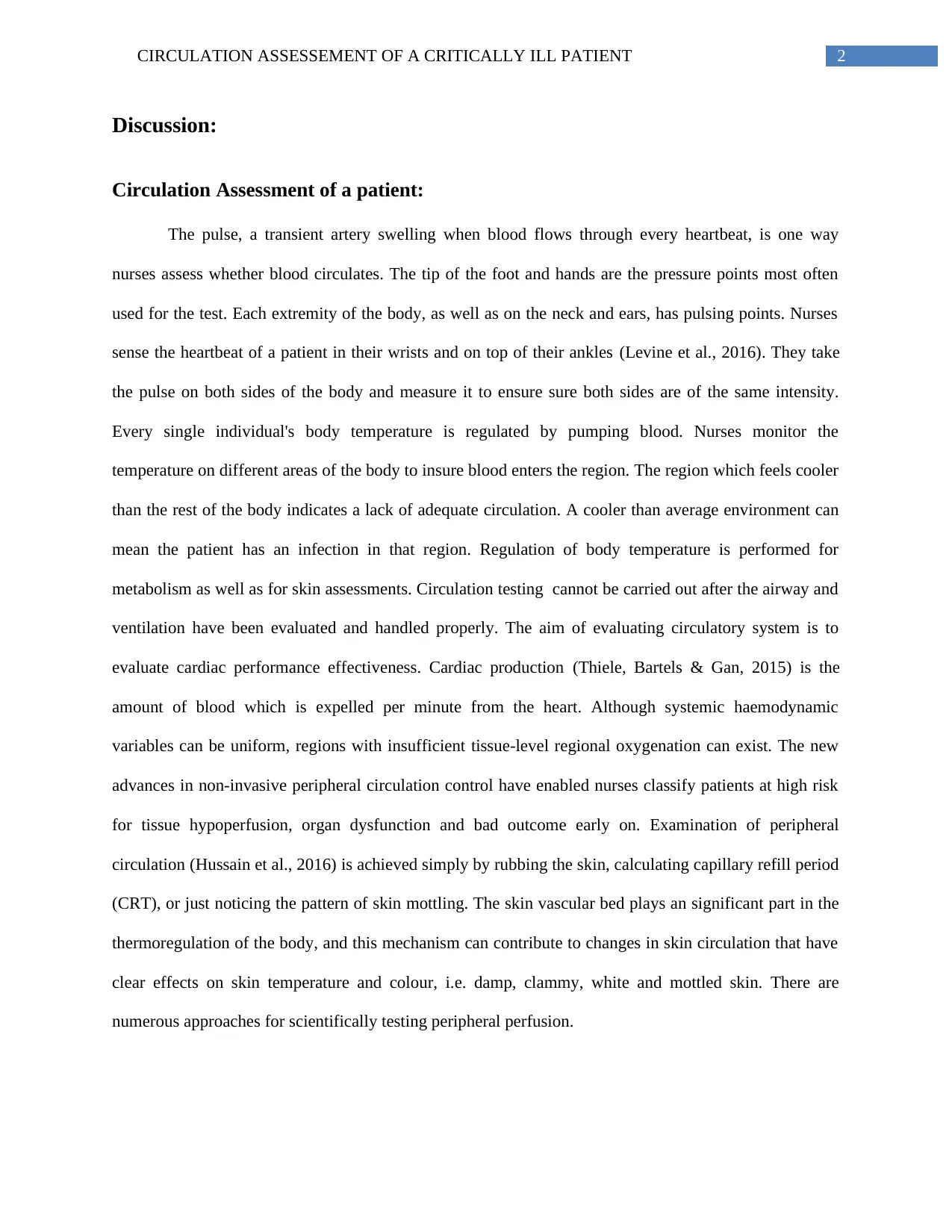
2CIRCULATION ASSESSEMENT OF A CRITICALLY ILL PATIENT
Discussion:
Circulation Assessment of a patient:
The pulse, a transient artery swelling when blood flows through every heartbeat, is one way
nurses assess whether blood circulates. The tip of the foot and hands are the pressure points most often
used for the test. Each extremity of the body, as well as on the neck and ears, has pulsing points. Nurses
sense the heartbeat of a patient in their wrists and on top of their ankles (Levine et al., 2016). They take
the pulse on both sides of the body and measure it to ensure sure both sides are of the same intensity.
Every single individual's body temperature is regulated by pumping blood. Nurses monitor the
temperature on different areas of the body to insure blood enters the region. The region which feels cooler
than the rest of the body indicates a lack of adequate circulation. A cooler than average environment can
mean the patient has an infection in that region. Regulation of body temperature is performed for
metabolism as well as for skin assessments. Circulation testing cannot be carried out after the airway and
ventilation have been evaluated and handled properly. The aim of evaluating circulatory system is to
evaluate cardiac performance effectiveness. Cardiac production (Thiele, Bartels & Gan, 2015) is the
amount of blood which is expelled per minute from the heart. Although systemic haemodynamic
variables can be uniform, regions with insufficient tissue-level regional oxygenation can exist. The new
advances in non-invasive peripheral circulation control have enabled nurses classify patients at high risk
for tissue hypoperfusion, organ dysfunction and bad outcome early on. Examination of peripheral
circulation (Hussain et al., 2016) is achieved simply by rubbing the skin, calculating capillary refill period
(CRT), or just noticing the pattern of skin mottling. The skin vascular bed plays an significant part in the
thermoregulation of the body, and this mechanism can contribute to changes in skin circulation that have
clear effects on skin temperature and colour, i.e. damp, clammy, white and mottled skin. There are
numerous approaches for scientifically testing peripheral perfusion.
Discussion:
Circulation Assessment of a patient:
The pulse, a transient artery swelling when blood flows through every heartbeat, is one way
nurses assess whether blood circulates. The tip of the foot and hands are the pressure points most often
used for the test. Each extremity of the body, as well as on the neck and ears, has pulsing points. Nurses
sense the heartbeat of a patient in their wrists and on top of their ankles (Levine et al., 2016). They take
the pulse on both sides of the body and measure it to ensure sure both sides are of the same intensity.
Every single individual's body temperature is regulated by pumping blood. Nurses monitor the
temperature on different areas of the body to insure blood enters the region. The region which feels cooler
than the rest of the body indicates a lack of adequate circulation. A cooler than average environment can
mean the patient has an infection in that region. Regulation of body temperature is performed for
metabolism as well as for skin assessments. Circulation testing cannot be carried out after the airway and
ventilation have been evaluated and handled properly. The aim of evaluating circulatory system is to
evaluate cardiac performance effectiveness. Cardiac production (Thiele, Bartels & Gan, 2015) is the
amount of blood which is expelled per minute from the heart. Although systemic haemodynamic
variables can be uniform, regions with insufficient tissue-level regional oxygenation can exist. The new
advances in non-invasive peripheral circulation control have enabled nurses classify patients at high risk
for tissue hypoperfusion, organ dysfunction and bad outcome early on. Examination of peripheral
circulation (Hussain et al., 2016) is achieved simply by rubbing the skin, calculating capillary refill period
(CRT), or just noticing the pattern of skin mottling. The skin vascular bed plays an significant part in the
thermoregulation of the body, and this mechanism can contribute to changes in skin circulation that have
clear effects on skin temperature and colour, i.e. damp, clammy, white and mottled skin. There are
numerous approaches for scientifically testing peripheral perfusion.
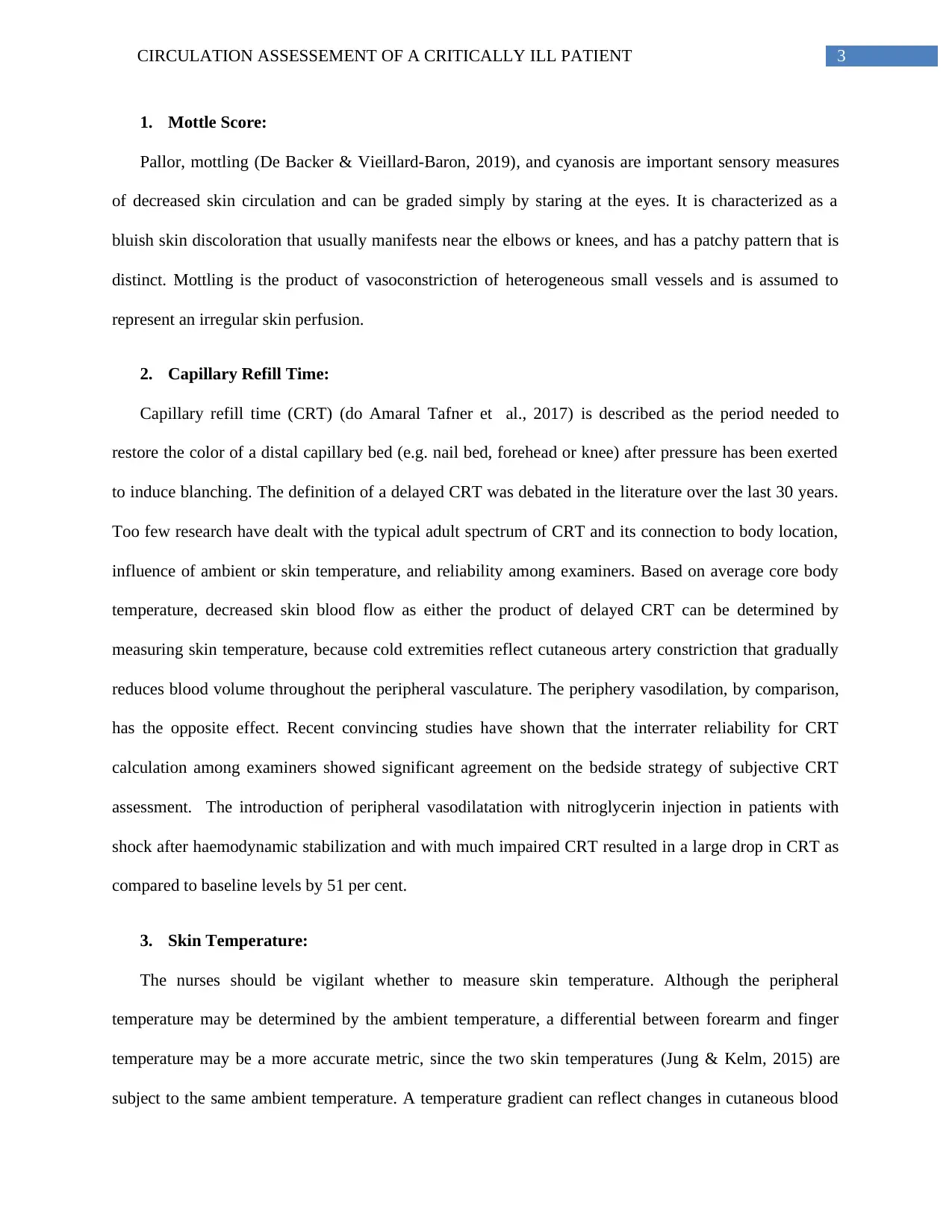
3CIRCULATION ASSESSEMENT OF A CRITICALLY ILL PATIENT
1. Mottle Score:
Pallor, mottling (De Backer & Vieillard-Baron, 2019), and cyanosis are important sensory measures
of decreased skin circulation and can be graded simply by staring at the eyes. It is characterized as a
bluish skin discoloration that usually manifests near the elbows or knees, and has a patchy pattern that is
distinct. Mottling is the product of vasoconstriction of heterogeneous small vessels and is assumed to
represent an irregular skin perfusion.
2. Capillary Refill Time:
Capillary refill time (CRT) (do Amaral Tafner et al., 2017) is described as the period needed to
restore the color of a distal capillary bed (e.g. nail bed, forehead or knee) after pressure has been exerted
to induce blanching. The definition of a delayed CRT was debated in the literature over the last 30 years.
Too few research have dealt with the typical adult spectrum of CRT and its connection to body location,
influence of ambient or skin temperature, and reliability among examiners. Based on average core body
temperature, decreased skin blood flow as either the product of delayed CRT can be determined by
measuring skin temperature, because cold extremities reflect cutaneous artery constriction that gradually
reduces blood volume throughout the peripheral vasculature. The periphery vasodilation, by comparison,
has the opposite effect. Recent convincing studies have shown that the interrater reliability for CRT
calculation among examiners showed significant agreement on the bedside strategy of subjective CRT
assessment. The introduction of peripheral vasodilatation with nitroglycerin injection in patients with
shock after haemodynamic stabilization and with much impaired CRT resulted in a large drop in CRT as
compared to baseline levels by 51 per cent.
3. Skin Temperature:
The nurses should be vigilant whether to measure skin temperature. Although the peripheral
temperature may be determined by the ambient temperature, a differential between forearm and finger
temperature may be a more accurate metric, since the two skin temperatures (Jung & Kelm, 2015) are
subject to the same ambient temperature. A temperature gradient can reflect changes in cutaneous blood
1. Mottle Score:
Pallor, mottling (De Backer & Vieillard-Baron, 2019), and cyanosis are important sensory measures
of decreased skin circulation and can be graded simply by staring at the eyes. It is characterized as a
bluish skin discoloration that usually manifests near the elbows or knees, and has a patchy pattern that is
distinct. Mottling is the product of vasoconstriction of heterogeneous small vessels and is assumed to
represent an irregular skin perfusion.
2. Capillary Refill Time:
Capillary refill time (CRT) (do Amaral Tafner et al., 2017) is described as the period needed to
restore the color of a distal capillary bed (e.g. nail bed, forehead or knee) after pressure has been exerted
to induce blanching. The definition of a delayed CRT was debated in the literature over the last 30 years.
Too few research have dealt with the typical adult spectrum of CRT and its connection to body location,
influence of ambient or skin temperature, and reliability among examiners. Based on average core body
temperature, decreased skin blood flow as either the product of delayed CRT can be determined by
measuring skin temperature, because cold extremities reflect cutaneous artery constriction that gradually
reduces blood volume throughout the peripheral vasculature. The periphery vasodilation, by comparison,
has the opposite effect. Recent convincing studies have shown that the interrater reliability for CRT
calculation among examiners showed significant agreement on the bedside strategy of subjective CRT
assessment. The introduction of peripheral vasodilatation with nitroglycerin injection in patients with
shock after haemodynamic stabilization and with much impaired CRT resulted in a large drop in CRT as
compared to baseline levels by 51 per cent.
3. Skin Temperature:
The nurses should be vigilant whether to measure skin temperature. Although the peripheral
temperature may be determined by the ambient temperature, a differential between forearm and finger
temperature may be a more accurate metric, since the two skin temperatures (Jung & Kelm, 2015) are
subject to the same ambient temperature. A temperature gradient can reflect changes in cutaneous blood
Secure Best Marks with AI Grader
Need help grading? Try our AI Grader for instant feedback on your assignments.
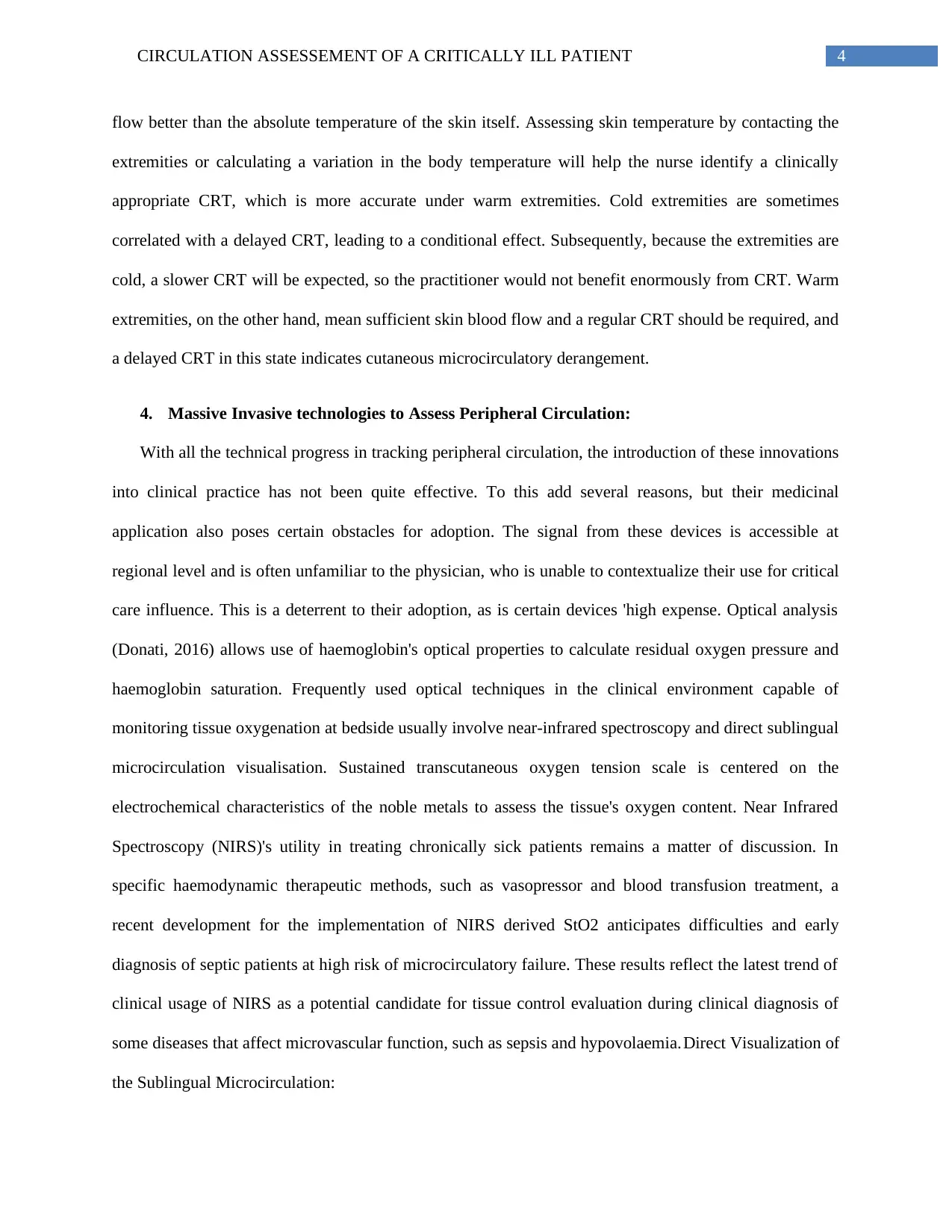
4CIRCULATION ASSESSEMENT OF A CRITICALLY ILL PATIENT
flow better than the absolute temperature of the skin itself. Assessing skin temperature by contacting the
extremities or calculating a variation in the body temperature will help the nurse identify a clinically
appropriate CRT, which is more accurate under warm extremities. Cold extremities are sometimes
correlated with a delayed CRT, leading to a conditional effect. Subsequently, because the extremities are
cold, a slower CRT will be expected, so the practitioner would not benefit enormously from CRT. Warm
extremities, on the other hand, mean sufficient skin blood flow and a regular CRT should be required, and
a delayed CRT in this state indicates cutaneous microcirculatory derangement.
4. Massive Invasive technologies to Assess Peripheral Circulation:
With all the technical progress in tracking peripheral circulation, the introduction of these innovations
into clinical practice has not been quite effective. To this add several reasons, but their medicinal
application also poses certain obstacles for adoption. The signal from these devices is accessible at
regional level and is often unfamiliar to the physician, who is unable to contextualize their use for critical
care influence. This is a deterrent to their adoption, as is certain devices 'high expense. Optical analysis
(Donati, 2016) allows use of haemoglobin's optical properties to calculate residual oxygen pressure and
haemoglobin saturation. Frequently used optical techniques in the clinical environment capable of
monitoring tissue oxygenation at bedside usually involve near-infrared spectroscopy and direct sublingual
microcirculation visualisation. Sustained transcutaneous oxygen tension scale is centered on the
electrochemical characteristics of the noble metals to assess the tissue's oxygen content. Near Infrared
Spectroscopy (NIRS)'s utility in treating chronically sick patients remains a matter of discussion. In
specific haemodynamic therapeutic methods, such as vasopressor and blood transfusion treatment, a
recent development for the implementation of NIRS derived StO2 anticipates difficulties and early
diagnosis of septic patients at high risk of microcirculatory failure. These results reflect the latest trend of
clinical usage of NIRS as a potential candidate for tissue control evaluation during clinical diagnosis of
some diseases that affect microvascular function, such as sepsis and hypovolaemia.Direct Visualization of
the Sublingual Microcirculation:
flow better than the absolute temperature of the skin itself. Assessing skin temperature by contacting the
extremities or calculating a variation in the body temperature will help the nurse identify a clinically
appropriate CRT, which is more accurate under warm extremities. Cold extremities are sometimes
correlated with a delayed CRT, leading to a conditional effect. Subsequently, because the extremities are
cold, a slower CRT will be expected, so the practitioner would not benefit enormously from CRT. Warm
extremities, on the other hand, mean sufficient skin blood flow and a regular CRT should be required, and
a delayed CRT in this state indicates cutaneous microcirculatory derangement.
4. Massive Invasive technologies to Assess Peripheral Circulation:
With all the technical progress in tracking peripheral circulation, the introduction of these innovations
into clinical practice has not been quite effective. To this add several reasons, but their medicinal
application also poses certain obstacles for adoption. The signal from these devices is accessible at
regional level and is often unfamiliar to the physician, who is unable to contextualize their use for critical
care influence. This is a deterrent to their adoption, as is certain devices 'high expense. Optical analysis
(Donati, 2016) allows use of haemoglobin's optical properties to calculate residual oxygen pressure and
haemoglobin saturation. Frequently used optical techniques in the clinical environment capable of
monitoring tissue oxygenation at bedside usually involve near-infrared spectroscopy and direct sublingual
microcirculation visualisation. Sustained transcutaneous oxygen tension scale is centered on the
electrochemical characteristics of the noble metals to assess the tissue's oxygen content. Near Infrared
Spectroscopy (NIRS)'s utility in treating chronically sick patients remains a matter of discussion. In
specific haemodynamic therapeutic methods, such as vasopressor and blood transfusion treatment, a
recent development for the implementation of NIRS derived StO2 anticipates difficulties and early
diagnosis of septic patients at high risk of microcirculatory failure. These results reflect the latest trend of
clinical usage of NIRS as a potential candidate for tissue control evaluation during clinical diagnosis of
some diseases that affect microvascular function, such as sepsis and hypovolaemia.Direct Visualization of
the Sublingual Microcirculation:
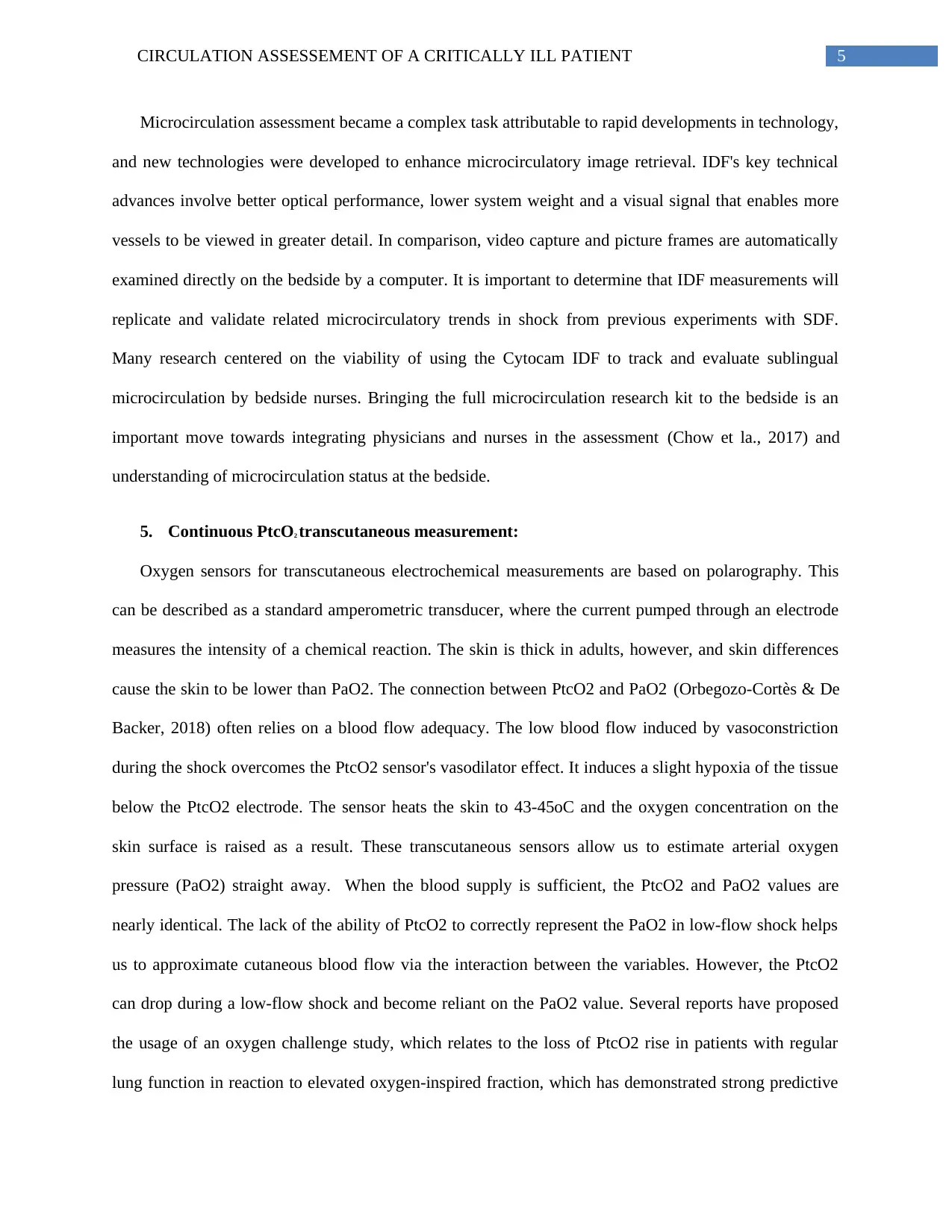
5CIRCULATION ASSESSEMENT OF A CRITICALLY ILL PATIENT
Microcirculation assessment became a complex task attributable to rapid developments in technology,
and new technologies were developed to enhance microcirculatory image retrieval. IDF's key technical
advances involve better optical performance, lower system weight and a visual signal that enables more
vessels to be viewed in greater detail. In comparison, video capture and picture frames are automatically
examined directly on the bedside by a computer. It is important to determine that IDF measurements will
replicate and validate related microcirculatory trends in shock from previous experiments with SDF.
Many research centered on the viability of using the Cytocam IDF to track and evaluate sublingual
microcirculation by bedside nurses. Bringing the full microcirculation research kit to the bedside is an
important move towards integrating physicians and nurses in the assessment (Chow et la., 2017) and
understanding of microcirculation status at the bedside.
5. Continuous PtcO2 transcutaneous measurement:
Oxygen sensors for transcutaneous electrochemical measurements are based on polarography. This
can be described as a standard amperometric transducer, where the current pumped through an electrode
measures the intensity of a chemical reaction. The skin is thick in adults, however, and skin differences
cause the skin to be lower than PaO2. The connection between PtcO2 and PaO2 (Orbegozo-Cortès & De
Backer, 2018) often relies on a blood flow adequacy. The low blood flow induced by vasoconstriction
during the shock overcomes the PtcO2 sensor's vasodilator effect. It induces a slight hypoxia of the tissue
below the PtcO2 electrode. The sensor heats the skin to 43-45oC and the oxygen concentration on the
skin surface is raised as a result. These transcutaneous sensors allow us to estimate arterial oxygen
pressure (PaO2) straight away. When the blood supply is sufficient, the PtcO2 and PaO2 values are
nearly identical. The lack of the ability of PtcO2 to correctly represent the PaO2 in low-flow shock helps
us to approximate cutaneous blood flow via the interaction between the variables. However, the PtcO2
can drop during a low-flow shock and become reliant on the PaO2 value. Several reports have proposed
the usage of an oxygen challenge study, which relates to the loss of PtcO2 rise in patients with regular
lung function in reaction to elevated oxygen-inspired fraction, which has demonstrated strong predictive
Microcirculation assessment became a complex task attributable to rapid developments in technology,
and new technologies were developed to enhance microcirculatory image retrieval. IDF's key technical
advances involve better optical performance, lower system weight and a visual signal that enables more
vessels to be viewed in greater detail. In comparison, video capture and picture frames are automatically
examined directly on the bedside by a computer. It is important to determine that IDF measurements will
replicate and validate related microcirculatory trends in shock from previous experiments with SDF.
Many research centered on the viability of using the Cytocam IDF to track and evaluate sublingual
microcirculation by bedside nurses. Bringing the full microcirculation research kit to the bedside is an
important move towards integrating physicians and nurses in the assessment (Chow et la., 2017) and
understanding of microcirculation status at the bedside.
5. Continuous PtcO2 transcutaneous measurement:
Oxygen sensors for transcutaneous electrochemical measurements are based on polarography. This
can be described as a standard amperometric transducer, where the current pumped through an electrode
measures the intensity of a chemical reaction. The skin is thick in adults, however, and skin differences
cause the skin to be lower than PaO2. The connection between PtcO2 and PaO2 (Orbegozo-Cortès & De
Backer, 2018) often relies on a blood flow adequacy. The low blood flow induced by vasoconstriction
during the shock overcomes the PtcO2 sensor's vasodilator effect. It induces a slight hypoxia of the tissue
below the PtcO2 electrode. The sensor heats the skin to 43-45oC and the oxygen concentration on the
skin surface is raised as a result. These transcutaneous sensors allow us to estimate arterial oxygen
pressure (PaO2) straight away. When the blood supply is sufficient, the PtcO2 and PaO2 values are
nearly identical. The lack of the ability of PtcO2 to correctly represent the PaO2 in low-flow shock helps
us to approximate cutaneous blood flow via the interaction between the variables. However, the PtcO2
can drop during a low-flow shock and become reliant on the PaO2 value. Several reports have proposed
the usage of an oxygen challenge study, which relates to the loss of PtcO2 rise in patients with regular
lung function in reaction to elevated oxygen-inspired fraction, which has demonstrated strong predictive
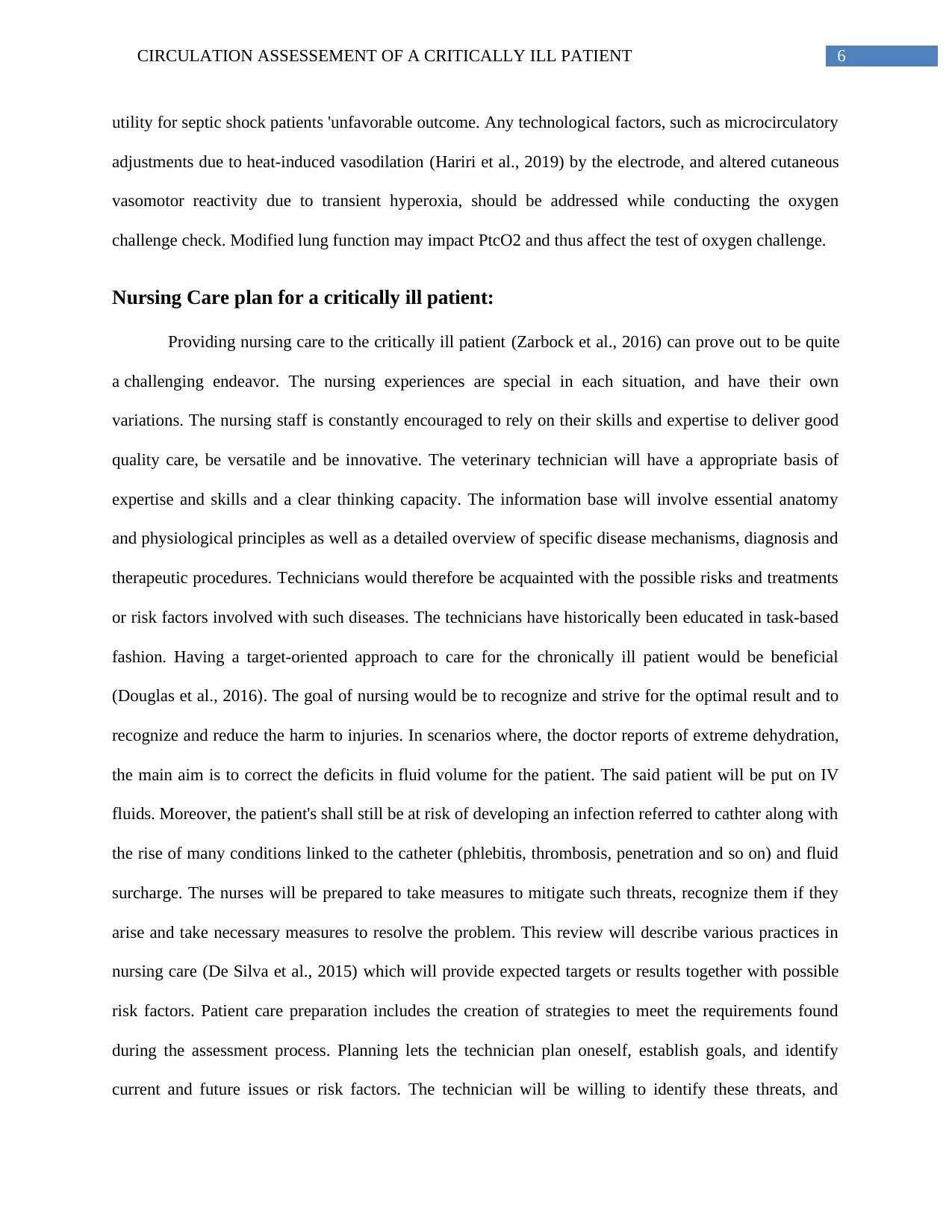
6CIRCULATION ASSESSEMENT OF A CRITICALLY ILL PATIENT
utility for septic shock patients 'unfavorable outcome. Any technological factors, such as microcirculatory
adjustments due to heat-induced vasodilation (Hariri et al., 2019) by the electrode, and altered cutaneous
vasomotor reactivity due to transient hyperoxia, should be addressed while conducting the oxygen
challenge check. Modified lung function may impact PtcO2 and thus affect the test of oxygen challenge.
Nursing Care plan for a critically ill patient:
Providing nursing care to the critically ill patient (Zarbock et al., 2016) can prove out to be quite
a challenging endeavor. The nursing experiences are special in each situation, and have their own
variations. The nursing staff is constantly encouraged to rely on their skills and expertise to deliver good
quality care, be versatile and be innovative. The veterinary technician will have a appropriate basis of
expertise and skills and a clear thinking capacity. The information base will involve essential anatomy
and physiological principles as well as a detailed overview of specific disease mechanisms, diagnosis and
therapeutic procedures. Technicians would therefore be acquainted with the possible risks and treatments
or risk factors involved with such diseases. The technicians have historically been educated in task-based
fashion. Having a target-oriented approach to care for the chronically ill patient would be beneficial
(Douglas et al., 2016). The goal of nursing would be to recognize and strive for the optimal result and to
recognize and reduce the harm to injuries. In scenarios where, the doctor reports of extreme dehydration,
the main aim is to correct the deficits in fluid volume for the patient. The said patient will be put on IV
fluids. Moreover, the patient's shall still be at risk of developing an infection referred to cathter along with
the rise of many conditions linked to the catheter (phlebitis, thrombosis, penetration and so on) and fluid
surcharge. The nurses will be prepared to take measures to mitigate such threats, recognize them if they
arise and take necessary measures to resolve the problem. This review will describe various practices in
nursing care (De Silva et al., 2015) which will provide expected targets or results together with possible
risk factors. Patient care preparation includes the creation of strategies to meet the requirements found
during the assessment process. Planning lets the technician plan oneself, establish goals, and identify
current and future issues or risk factors. The technician will be willing to identify these threats, and
utility for septic shock patients 'unfavorable outcome. Any technological factors, such as microcirculatory
adjustments due to heat-induced vasodilation (Hariri et al., 2019) by the electrode, and altered cutaneous
vasomotor reactivity due to transient hyperoxia, should be addressed while conducting the oxygen
challenge check. Modified lung function may impact PtcO2 and thus affect the test of oxygen challenge.
Nursing Care plan for a critically ill patient:
Providing nursing care to the critically ill patient (Zarbock et al., 2016) can prove out to be quite
a challenging endeavor. The nursing experiences are special in each situation, and have their own
variations. The nursing staff is constantly encouraged to rely on their skills and expertise to deliver good
quality care, be versatile and be innovative. The veterinary technician will have a appropriate basis of
expertise and skills and a clear thinking capacity. The information base will involve essential anatomy
and physiological principles as well as a detailed overview of specific disease mechanisms, diagnosis and
therapeutic procedures. Technicians would therefore be acquainted with the possible risks and treatments
or risk factors involved with such diseases. The technicians have historically been educated in task-based
fashion. Having a target-oriented approach to care for the chronically ill patient would be beneficial
(Douglas et al., 2016). The goal of nursing would be to recognize and strive for the optimal result and to
recognize and reduce the harm to injuries. In scenarios where, the doctor reports of extreme dehydration,
the main aim is to correct the deficits in fluid volume for the patient. The said patient will be put on IV
fluids. Moreover, the patient's shall still be at risk of developing an infection referred to cathter along with
the rise of many conditions linked to the catheter (phlebitis, thrombosis, penetration and so on) and fluid
surcharge. The nurses will be prepared to take measures to mitigate such threats, recognize them if they
arise and take necessary measures to resolve the problem. This review will describe various practices in
nursing care (De Silva et al., 2015) which will provide expected targets or results together with possible
risk factors. Patient care preparation includes the creation of strategies to meet the requirements found
during the assessment process. Planning lets the technician plan oneself, establish goals, and identify
current and future issues or risk factors. The technician will be willing to identify these threats, and
Paraphrase This Document
Need a fresh take? Get an instant paraphrase of this document with our AI Paraphraser
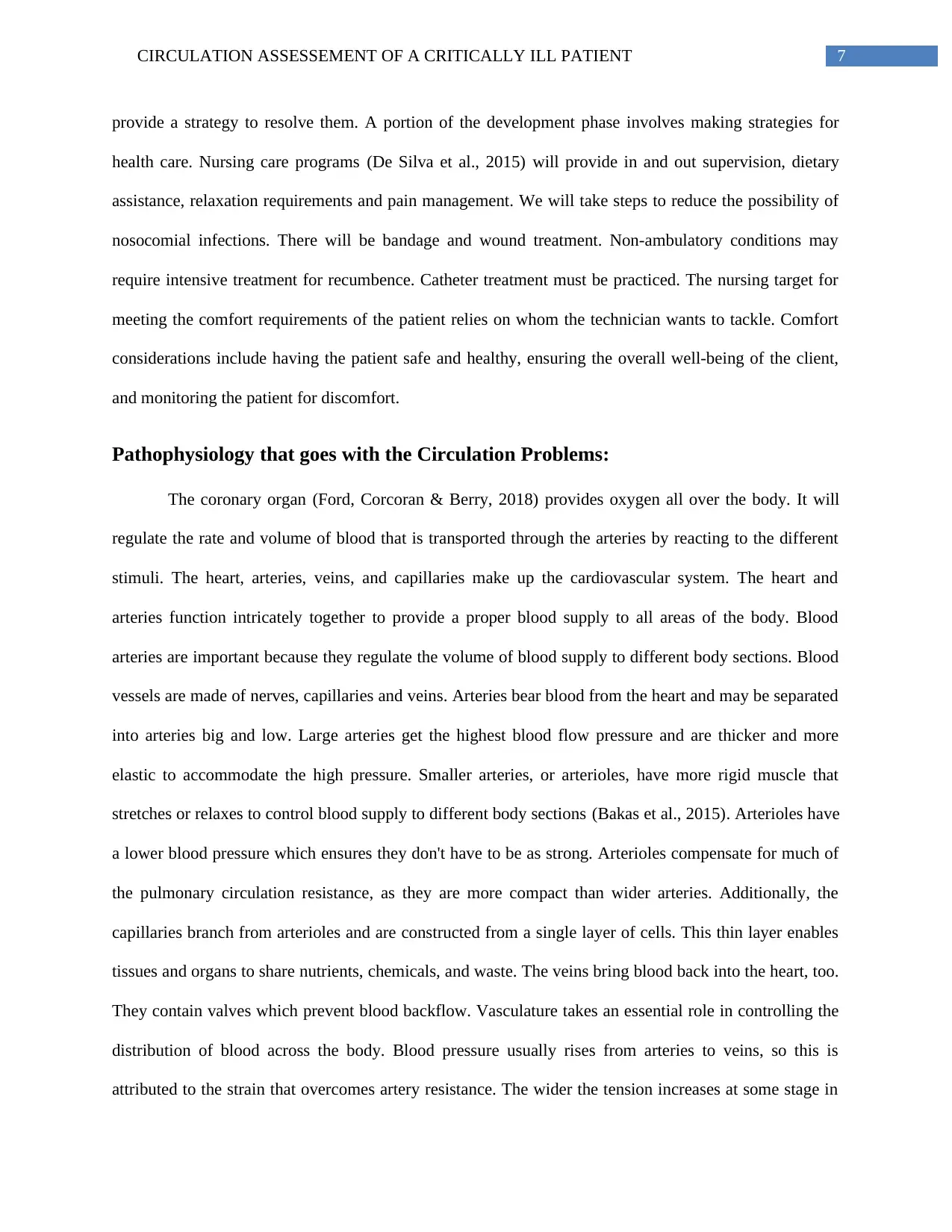
7CIRCULATION ASSESSEMENT OF A CRITICALLY ILL PATIENT
provide a strategy to resolve them. A portion of the development phase involves making strategies for
health care. Nursing care programs (De Silva et al., 2015) will provide in and out supervision, dietary
assistance, relaxation requirements and pain management. We will take steps to reduce the possibility of
nosocomial infections. There will be bandage and wound treatment. Non-ambulatory conditions may
require intensive treatment for recumbence. Catheter treatment must be practiced. The nursing target for
meeting the comfort requirements of the patient relies on whom the technician wants to tackle. Comfort
considerations include having the patient safe and healthy, ensuring the overall well-being of the client,
and monitoring the patient for discomfort.
Pathophysiology that goes with the Circulation Problems:
The coronary organ (Ford, Corcoran & Berry, 2018) provides oxygen all over the body. It will
regulate the rate and volume of blood that is transported through the arteries by reacting to the different
stimuli. The heart, arteries, veins, and capillaries make up the cardiovascular system. The heart and
arteries function intricately together to provide a proper blood supply to all areas of the body. Blood
arteries are important because they regulate the volume of blood supply to different body sections. Blood
vessels are made of nerves, capillaries and veins. Arteries bear blood from the heart and may be separated
into arteries big and low. Large arteries get the highest blood flow pressure and are thicker and more
elastic to accommodate the high pressure. Smaller arteries, or arterioles, have more rigid muscle that
stretches or relaxes to control blood supply to different body sections (Bakas et al., 2015). Arterioles have
a lower blood pressure which ensures they don't have to be as strong. Arterioles compensate for much of
the pulmonary circulation resistance, as they are more compact than wider arteries. Additionally, the
capillaries branch from arterioles and are constructed from a single layer of cells. This thin layer enables
tissues and organs to share nutrients, chemicals, and waste. The veins bring blood back into the heart, too.
They contain valves which prevent blood backflow. Vasculature takes an essential role in controlling the
distribution of blood across the body. Blood pressure usually rises from arteries to veins, so this is
attributed to the strain that overcomes artery resistance. The wider the tension increases at some stage in
provide a strategy to resolve them. A portion of the development phase involves making strategies for
health care. Nursing care programs (De Silva et al., 2015) will provide in and out supervision, dietary
assistance, relaxation requirements and pain management. We will take steps to reduce the possibility of
nosocomial infections. There will be bandage and wound treatment. Non-ambulatory conditions may
require intensive treatment for recumbence. Catheter treatment must be practiced. The nursing target for
meeting the comfort requirements of the patient relies on whom the technician wants to tackle. Comfort
considerations include having the patient safe and healthy, ensuring the overall well-being of the client,
and monitoring the patient for discomfort.
Pathophysiology that goes with the Circulation Problems:
The coronary organ (Ford, Corcoran & Berry, 2018) provides oxygen all over the body. It will
regulate the rate and volume of blood that is transported through the arteries by reacting to the different
stimuli. The heart, arteries, veins, and capillaries make up the cardiovascular system. The heart and
arteries function intricately together to provide a proper blood supply to all areas of the body. Blood
arteries are important because they regulate the volume of blood supply to different body sections. Blood
vessels are made of nerves, capillaries and veins. Arteries bear blood from the heart and may be separated
into arteries big and low. Large arteries get the highest blood flow pressure and are thicker and more
elastic to accommodate the high pressure. Smaller arteries, or arterioles, have more rigid muscle that
stretches or relaxes to control blood supply to different body sections (Bakas et al., 2015). Arterioles have
a lower blood pressure which ensures they don't have to be as strong. Arterioles compensate for much of
the pulmonary circulation resistance, as they are more compact than wider arteries. Additionally, the
capillaries branch from arterioles and are constructed from a single layer of cells. This thin layer enables
tissues and organs to share nutrients, chemicals, and waste. The veins bring blood back into the heart, too.
They contain valves which prevent blood backflow. Vasculature takes an essential role in controlling the
distribution of blood across the body. Blood pressure usually rises from arteries to veins, so this is
attributed to the strain that overcomes artery resistance. The wider the tension increases at some stage in
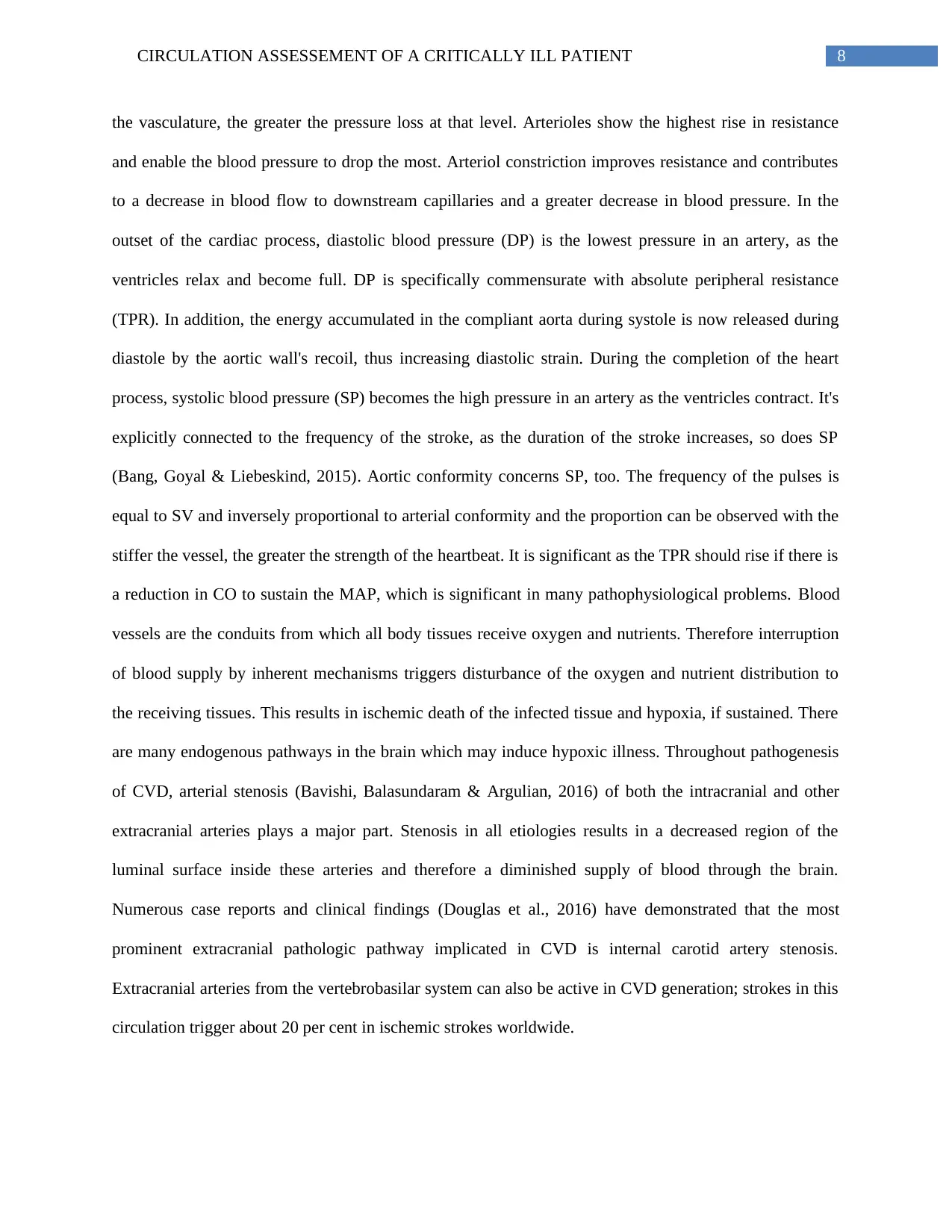
8CIRCULATION ASSESSEMENT OF A CRITICALLY ILL PATIENT
the vasculature, the greater the pressure loss at that level. Arterioles show the highest rise in resistance
and enable the blood pressure to drop the most. Arteriol constriction improves resistance and contributes
to a decrease in blood flow to downstream capillaries and a greater decrease in blood pressure. In the
outset of the cardiac process, diastolic blood pressure (DP) is the lowest pressure in an artery, as the
ventricles relax and become full. DP is specifically commensurate with absolute peripheral resistance
(TPR). In addition, the energy accumulated in the compliant aorta during systole is now released during
diastole by the aortic wall's recoil, thus increasing diastolic strain. During the completion of the heart
process, systolic blood pressure (SP) becomes the high pressure in an artery as the ventricles contract. It's
explicitly connected to the frequency of the stroke, as the duration of the stroke increases, so does SP
(Bang, Goyal & Liebeskind, 2015). Aortic conformity concerns SP, too. The frequency of the pulses is
equal to SV and inversely proportional to arterial conformity and the proportion can be observed with the
stiffer the vessel, the greater the strength of the heartbeat. It is significant as the TPR should rise if there is
a reduction in CO to sustain the MAP, which is significant in many pathophysiological problems. Blood
vessels are the conduits from which all body tissues receive oxygen and nutrients. Therefore interruption
of blood supply by inherent mechanisms triggers disturbance of the oxygen and nutrient distribution to
the receiving tissues. This results in ischemic death of the infected tissue and hypoxia, if sustained. There
are many endogenous pathways in the brain which may induce hypoxic illness. Throughout pathogenesis
of CVD, arterial stenosis (Bavishi, Balasundaram & Argulian, 2016) of both the intracranial and other
extracranial arteries plays a major part. Stenosis in all etiologies results in a decreased region of the
luminal surface inside these arteries and therefore a diminished supply of blood through the brain.
Numerous case reports and clinical findings (Douglas et al., 2016) have demonstrated that the most
prominent extracranial pathologic pathway implicated in CVD is internal carotid artery stenosis.
Extracranial arteries from the vertebrobasilar system can also be active in CVD generation; strokes in this
circulation trigger about 20 per cent in ischemic strokes worldwide.
the vasculature, the greater the pressure loss at that level. Arterioles show the highest rise in resistance
and enable the blood pressure to drop the most. Arteriol constriction improves resistance and contributes
to a decrease in blood flow to downstream capillaries and a greater decrease in blood pressure. In the
outset of the cardiac process, diastolic blood pressure (DP) is the lowest pressure in an artery, as the
ventricles relax and become full. DP is specifically commensurate with absolute peripheral resistance
(TPR). In addition, the energy accumulated in the compliant aorta during systole is now released during
diastole by the aortic wall's recoil, thus increasing diastolic strain. During the completion of the heart
process, systolic blood pressure (SP) becomes the high pressure in an artery as the ventricles contract. It's
explicitly connected to the frequency of the stroke, as the duration of the stroke increases, so does SP
(Bang, Goyal & Liebeskind, 2015). Aortic conformity concerns SP, too. The frequency of the pulses is
equal to SV and inversely proportional to arterial conformity and the proportion can be observed with the
stiffer the vessel, the greater the strength of the heartbeat. It is significant as the TPR should rise if there is
a reduction in CO to sustain the MAP, which is significant in many pathophysiological problems. Blood
vessels are the conduits from which all body tissues receive oxygen and nutrients. Therefore interruption
of blood supply by inherent mechanisms triggers disturbance of the oxygen and nutrient distribution to
the receiving tissues. This results in ischemic death of the infected tissue and hypoxia, if sustained. There
are many endogenous pathways in the brain which may induce hypoxic illness. Throughout pathogenesis
of CVD, arterial stenosis (Bavishi, Balasundaram & Argulian, 2016) of both the intracranial and other
extracranial arteries plays a major part. Stenosis in all etiologies results in a decreased region of the
luminal surface inside these arteries and therefore a diminished supply of blood through the brain.
Numerous case reports and clinical findings (Douglas et al., 2016) have demonstrated that the most
prominent extracranial pathologic pathway implicated in CVD is internal carotid artery stenosis.
Extracranial arteries from the vertebrobasilar system can also be active in CVD generation; strokes in this
circulation trigger about 20 per cent in ischemic strokes worldwide.
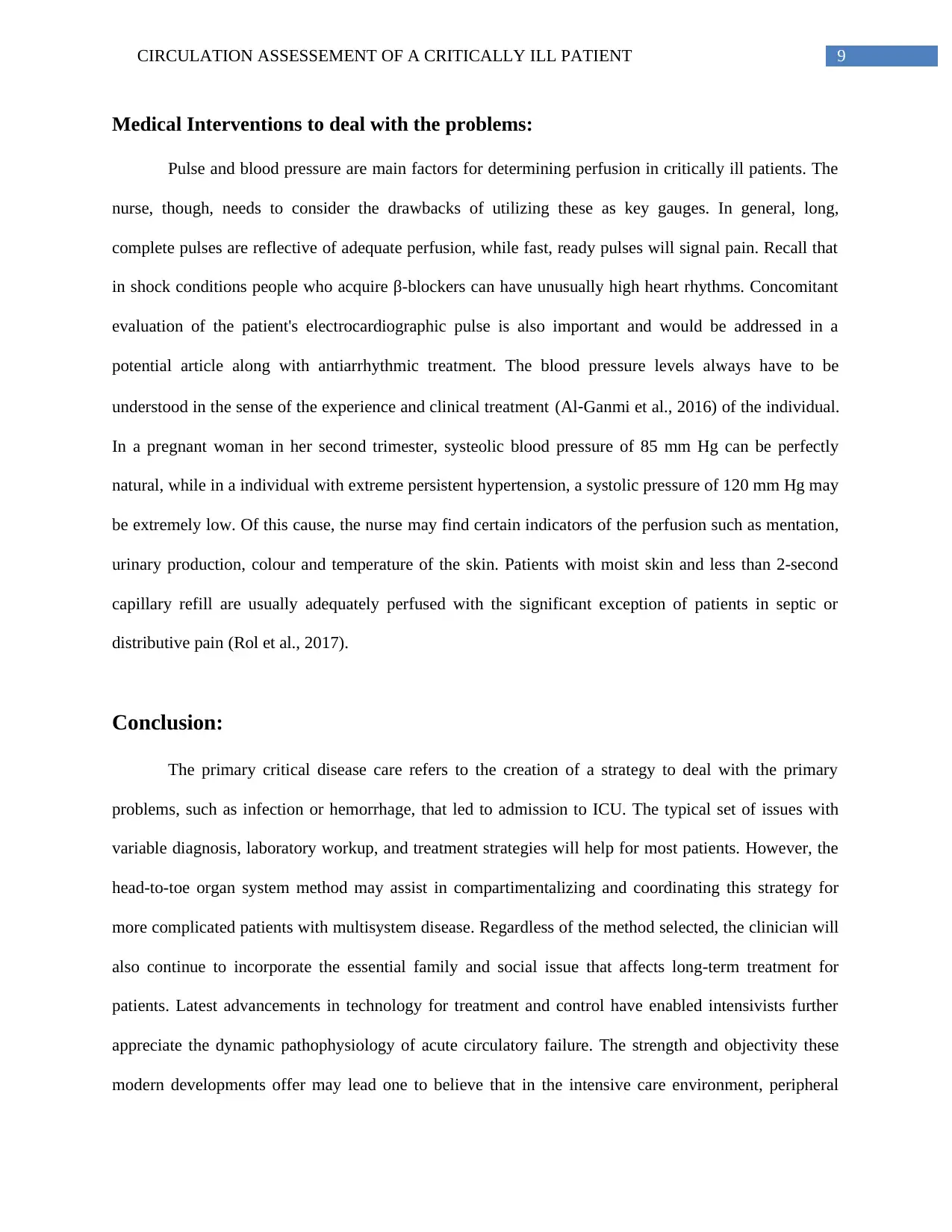
9CIRCULATION ASSESSEMENT OF A CRITICALLY ILL PATIENT
Medical Interventions to deal with the problems:
Pulse and blood pressure are main factors for determining perfusion in critically ill patients. The
nurse, though, needs to consider the drawbacks of utilizing these as key gauges. In general, long,
complete pulses are reflective of adequate perfusion, while fast, ready pulses will signal pain. Recall that
in shock conditions people who acquire β-blockers can have unusually high heart rhythms. Concomitant
evaluation of the patient's electrocardiographic pulse is also important and would be addressed in a
potential article along with antiarrhythmic treatment. The blood pressure levels always have to be
understood in the sense of the experience and clinical treatment (Al‐Ganmi et al., 2016) of the individual.
In a pregnant woman in her second trimester, systeolic blood pressure of 85 mm Hg can be perfectly
natural, while in a individual with extreme persistent hypertension, a systolic pressure of 120 mm Hg may
be extremely low. Of this cause, the nurse may find certain indicators of the perfusion such as mentation,
urinary production, colour and temperature of the skin. Patients with moist skin and less than 2-second
capillary refill are usually adequately perfused with the significant exception of patients in septic or
distributive pain (Rol et al., 2017).
Conclusion:
The primary critical disease care refers to the creation of a strategy to deal with the primary
problems, such as infection or hemorrhage, that led to admission to ICU. The typical set of issues with
variable diagnosis, laboratory workup, and treatment strategies will help for most patients. However, the
head-to-toe organ system method may assist in compartimentalizing and coordinating this strategy for
more complicated patients with multisystem disease. Regardless of the method selected, the clinician will
also continue to incorporate the essential family and social issue that affects long-term treatment for
patients. Latest advancements in technology for treatment and control have enabled intensivists further
appreciate the dynamic pathophysiology of acute circulatory failure. The strength and objectivity these
modern developments offer may lead one to believe that in the intensive care environment, peripheral
Medical Interventions to deal with the problems:
Pulse and blood pressure are main factors for determining perfusion in critically ill patients. The
nurse, though, needs to consider the drawbacks of utilizing these as key gauges. In general, long,
complete pulses are reflective of adequate perfusion, while fast, ready pulses will signal pain. Recall that
in shock conditions people who acquire β-blockers can have unusually high heart rhythms. Concomitant
evaluation of the patient's electrocardiographic pulse is also important and would be addressed in a
potential article along with antiarrhythmic treatment. The blood pressure levels always have to be
understood in the sense of the experience and clinical treatment (Al‐Ganmi et al., 2016) of the individual.
In a pregnant woman in her second trimester, systeolic blood pressure of 85 mm Hg can be perfectly
natural, while in a individual with extreme persistent hypertension, a systolic pressure of 120 mm Hg may
be extremely low. Of this cause, the nurse may find certain indicators of the perfusion such as mentation,
urinary production, colour and temperature of the skin. Patients with moist skin and less than 2-second
capillary refill are usually adequately perfused with the significant exception of patients in septic or
distributive pain (Rol et al., 2017).
Conclusion:
The primary critical disease care refers to the creation of a strategy to deal with the primary
problems, such as infection or hemorrhage, that led to admission to ICU. The typical set of issues with
variable diagnosis, laboratory workup, and treatment strategies will help for most patients. However, the
head-to-toe organ system method may assist in compartimentalizing and coordinating this strategy for
more complicated patients with multisystem disease. Regardless of the method selected, the clinician will
also continue to incorporate the essential family and social issue that affects long-term treatment for
patients. Latest advancements in technology for treatment and control have enabled intensivists further
appreciate the dynamic pathophysiology of acute circulatory failure. The strength and objectivity these
modern developments offer may lead one to believe that in the intensive care environment, peripheral
Secure Best Marks with AI Grader
Need help grading? Try our AI Grader for instant feedback on your assignments.
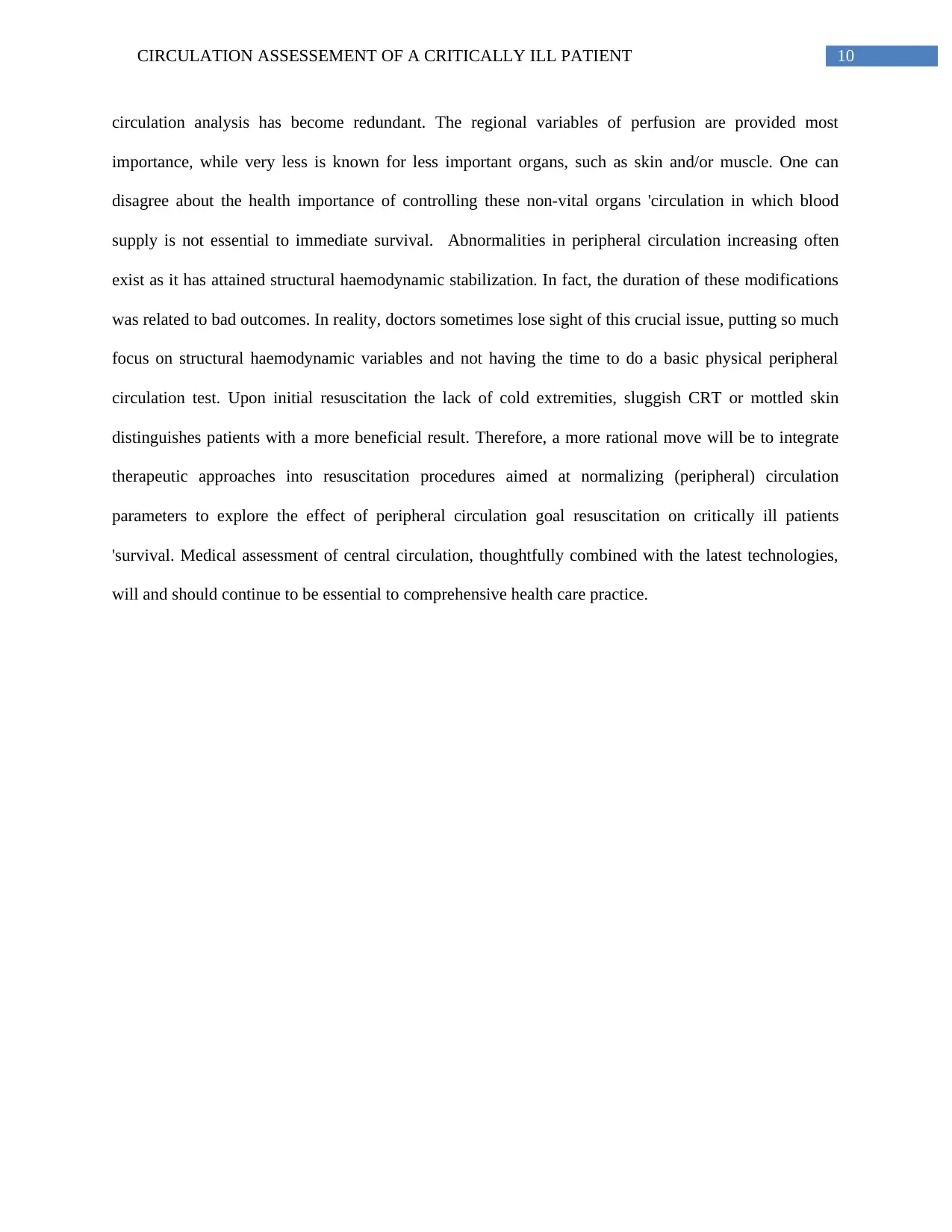
10CIRCULATION ASSESSEMENT OF A CRITICALLY ILL PATIENT
circulation analysis has become redundant. The regional variables of perfusion are provided most
importance, while very less is known for less important organs, such as skin and/or muscle. One can
disagree about the health importance of controlling these non-vital organs 'circulation in which blood
supply is not essential to immediate survival. Abnormalities in peripheral circulation increasing often
exist as it has attained structural haemodynamic stabilization. In fact, the duration of these modifications
was related to bad outcomes. In reality, doctors sometimes lose sight of this crucial issue, putting so much
focus on structural haemodynamic variables and not having the time to do a basic physical peripheral
circulation test. Upon initial resuscitation the lack of cold extremities, sluggish CRT or mottled skin
distinguishes patients with a more beneficial result. Therefore, a more rational move will be to integrate
therapeutic approaches into resuscitation procedures aimed at normalizing (peripheral) circulation
parameters to explore the effect of peripheral circulation goal resuscitation on critically ill patients
'survival. Medical assessment of central circulation, thoughtfully combined with the latest technologies,
will and should continue to be essential to comprehensive health care practice.
circulation analysis has become redundant. The regional variables of perfusion are provided most
importance, while very less is known for less important organs, such as skin and/or muscle. One can
disagree about the health importance of controlling these non-vital organs 'circulation in which blood
supply is not essential to immediate survival. Abnormalities in peripheral circulation increasing often
exist as it has attained structural haemodynamic stabilization. In fact, the duration of these modifications
was related to bad outcomes. In reality, doctors sometimes lose sight of this crucial issue, putting so much
focus on structural haemodynamic variables and not having the time to do a basic physical peripheral
circulation test. Upon initial resuscitation the lack of cold extremities, sluggish CRT or mottled skin
distinguishes patients with a more beneficial result. Therefore, a more rational move will be to integrate
therapeutic approaches into resuscitation procedures aimed at normalizing (peripheral) circulation
parameters to explore the effect of peripheral circulation goal resuscitation on critically ill patients
'survival. Medical assessment of central circulation, thoughtfully combined with the latest technologies,
will and should continue to be essential to comprehensive health care practice.
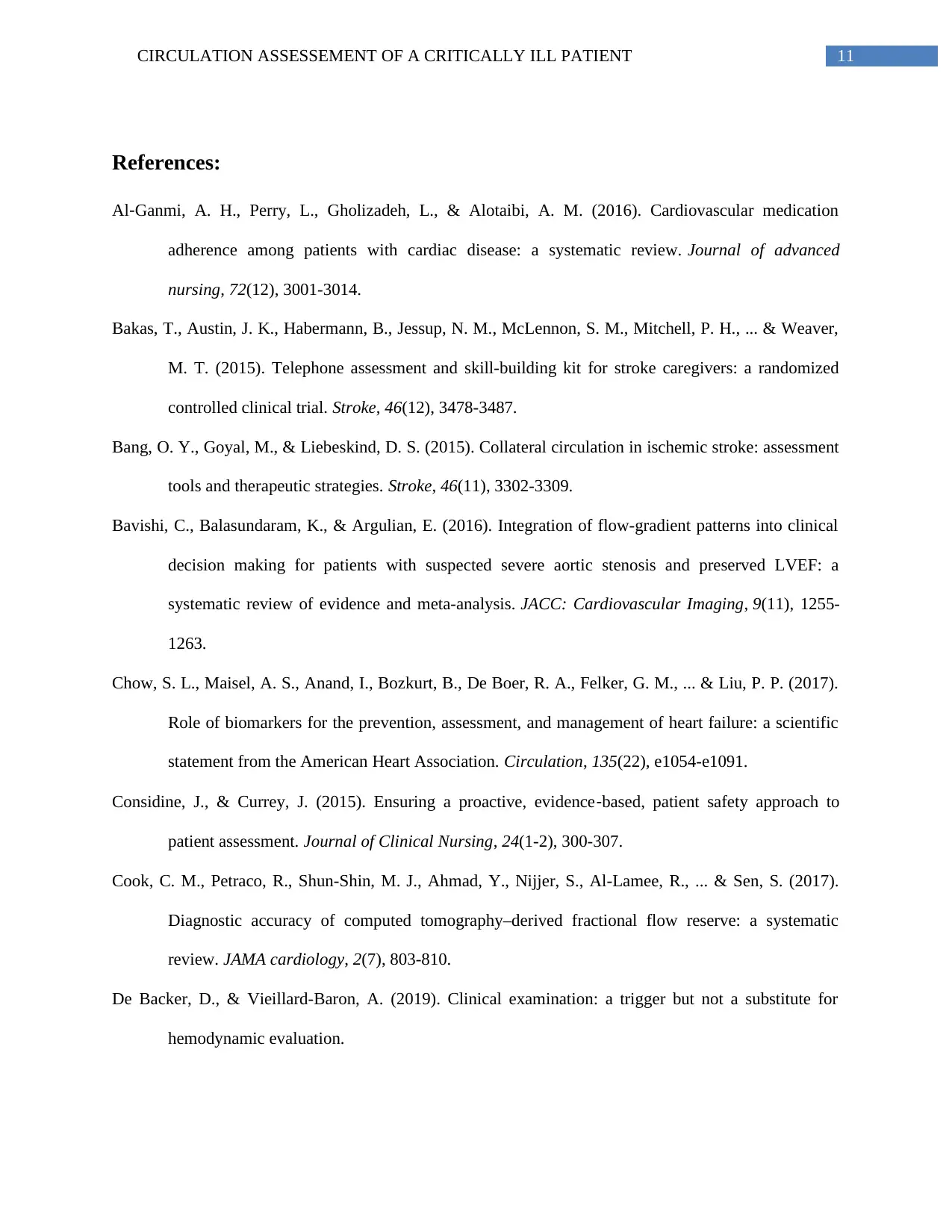
11CIRCULATION ASSESSEMENT OF A CRITICALLY ILL PATIENT
References:
Al‐Ganmi, A. H., Perry, L., Gholizadeh, L., & Alotaibi, A. M. (2016). Cardiovascular medication
adherence among patients with cardiac disease: a systematic review. Journal of advanced
nursing, 72(12), 3001-3014.
Bakas, T., Austin, J. K., Habermann, B., Jessup, N. M., McLennon, S. M., Mitchell, P. H., ... & Weaver,
M. T. (2015). Telephone assessment and skill-building kit for stroke caregivers: a randomized
controlled clinical trial. Stroke, 46(12), 3478-3487.
Bang, O. Y., Goyal, M., & Liebeskind, D. S. (2015). Collateral circulation in ischemic stroke: assessment
tools and therapeutic strategies. Stroke, 46(11), 3302-3309.
Bavishi, C., Balasundaram, K., & Argulian, E. (2016). Integration of flow-gradient patterns into clinical
decision making for patients with suspected severe aortic stenosis and preserved LVEF: a
systematic review of evidence and meta-analysis. JACC: Cardiovascular Imaging, 9(11), 1255-
1263.
Chow, S. L., Maisel, A. S., Anand, I., Bozkurt, B., De Boer, R. A., Felker, G. M., ... & Liu, P. P. (2017).
Role of biomarkers for the prevention, assessment, and management of heart failure: a scientific
statement from the American Heart Association. Circulation, 135(22), e1054-e1091.
Considine, J., & Currey, J. (2015). Ensuring a proactive, evidence‐based, patient safety approach to
patient assessment. Journal of Clinical Nursing, 24(1-2), 300-307.
Cook, C. M., Petraco, R., Shun-Shin, M. J., Ahmad, Y., Nijjer, S., Al-Lamee, R., ... & Sen, S. (2017).
Diagnostic accuracy of computed tomography–derived fractional flow reserve: a systematic
review. JAMA cardiology, 2(7), 803-810.
De Backer, D., & Vieillard-Baron, A. (2019). Clinical examination: a trigger but not a substitute for
hemodynamic evaluation.
References:
Al‐Ganmi, A. H., Perry, L., Gholizadeh, L., & Alotaibi, A. M. (2016). Cardiovascular medication
adherence among patients with cardiac disease: a systematic review. Journal of advanced
nursing, 72(12), 3001-3014.
Bakas, T., Austin, J. K., Habermann, B., Jessup, N. M., McLennon, S. M., Mitchell, P. H., ... & Weaver,
M. T. (2015). Telephone assessment and skill-building kit for stroke caregivers: a randomized
controlled clinical trial. Stroke, 46(12), 3478-3487.
Bang, O. Y., Goyal, M., & Liebeskind, D. S. (2015). Collateral circulation in ischemic stroke: assessment
tools and therapeutic strategies. Stroke, 46(11), 3302-3309.
Bavishi, C., Balasundaram, K., & Argulian, E. (2016). Integration of flow-gradient patterns into clinical
decision making for patients with suspected severe aortic stenosis and preserved LVEF: a
systematic review of evidence and meta-analysis. JACC: Cardiovascular Imaging, 9(11), 1255-
1263.
Chow, S. L., Maisel, A. S., Anand, I., Bozkurt, B., De Boer, R. A., Felker, G. M., ... & Liu, P. P. (2017).
Role of biomarkers for the prevention, assessment, and management of heart failure: a scientific
statement from the American Heart Association. Circulation, 135(22), e1054-e1091.
Considine, J., & Currey, J. (2015). Ensuring a proactive, evidence‐based, patient safety approach to
patient assessment. Journal of Clinical Nursing, 24(1-2), 300-307.
Cook, C. M., Petraco, R., Shun-Shin, M. J., Ahmad, Y., Nijjer, S., Al-Lamee, R., ... & Sen, S. (2017).
Diagnostic accuracy of computed tomography–derived fractional flow reserve: a systematic
review. JAMA cardiology, 2(7), 803-810.
De Backer, D., & Vieillard-Baron, A. (2019). Clinical examination: a trigger but not a substitute for
hemodynamic evaluation.
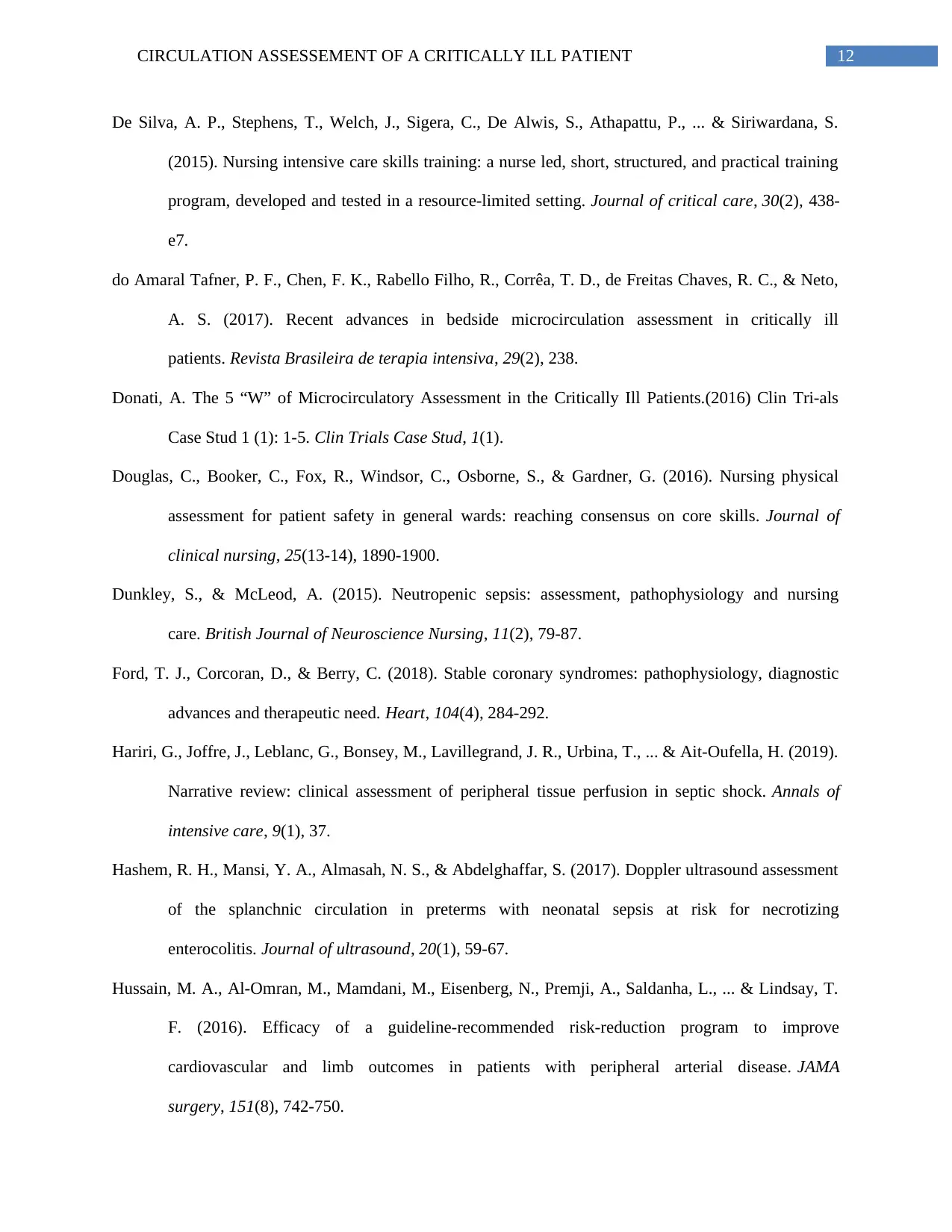
12CIRCULATION ASSESSEMENT OF A CRITICALLY ILL PATIENT
De Silva, A. P., Stephens, T., Welch, J., Sigera, C., De Alwis, S., Athapattu, P., ... & Siriwardana, S.
(2015). Nursing intensive care skills training: a nurse led, short, structured, and practical training
program, developed and tested in a resource-limited setting. Journal of critical care, 30(2), 438-
e7.
do Amaral Tafner, P. F., Chen, F. K., Rabello Filho, R., Corrêa, T. D., de Freitas Chaves, R. C., & Neto,
A. S. (2017). Recent advances in bedside microcirculation assessment in critically ill
patients. Revista Brasileira de terapia intensiva, 29(2), 238.
Donati, A. The 5 “W” of Microcirculatory Assessment in the Critically Ill Patients.(2016) Clin Tri-als
Case Stud 1 (1): 1-5. Clin Trials Case Stud, 1(1).
Douglas, C., Booker, C., Fox, R., Windsor, C., Osborne, S., & Gardner, G. (2016). Nursing physical
assessment for patient safety in general wards: reaching consensus on core skills. Journal of
clinical nursing, 25(13-14), 1890-1900.
Dunkley, S., & McLeod, A. (2015). Neutropenic sepsis: assessment, pathophysiology and nursing
care. British Journal of Neuroscience Nursing, 11(2), 79-87.
Ford, T. J., Corcoran, D., & Berry, C. (2018). Stable coronary syndromes: pathophysiology, diagnostic
advances and therapeutic need. Heart, 104(4), 284-292.
Hariri, G., Joffre, J., Leblanc, G., Bonsey, M., Lavillegrand, J. R., Urbina, T., ... & Ait-Oufella, H. (2019).
Narrative review: clinical assessment of peripheral tissue perfusion in septic shock. Annals of
intensive care, 9(1), 37.
Hashem, R. H., Mansi, Y. A., Almasah, N. S., & Abdelghaffar, S. (2017). Doppler ultrasound assessment
of the splanchnic circulation in preterms with neonatal sepsis at risk for necrotizing
enterocolitis. Journal of ultrasound, 20(1), 59-67.
Hussain, M. A., Al-Omran, M., Mamdani, M., Eisenberg, N., Premji, A., Saldanha, L., ... & Lindsay, T.
F. (2016). Efficacy of a guideline-recommended risk-reduction program to improve
cardiovascular and limb outcomes in patients with peripheral arterial disease. JAMA
surgery, 151(8), 742-750.
De Silva, A. P., Stephens, T., Welch, J., Sigera, C., De Alwis, S., Athapattu, P., ... & Siriwardana, S.
(2015). Nursing intensive care skills training: a nurse led, short, structured, and practical training
program, developed and tested in a resource-limited setting. Journal of critical care, 30(2), 438-
e7.
do Amaral Tafner, P. F., Chen, F. K., Rabello Filho, R., Corrêa, T. D., de Freitas Chaves, R. C., & Neto,
A. S. (2017). Recent advances in bedside microcirculation assessment in critically ill
patients. Revista Brasileira de terapia intensiva, 29(2), 238.
Donati, A. The 5 “W” of Microcirculatory Assessment in the Critically Ill Patients.(2016) Clin Tri-als
Case Stud 1 (1): 1-5. Clin Trials Case Stud, 1(1).
Douglas, C., Booker, C., Fox, R., Windsor, C., Osborne, S., & Gardner, G. (2016). Nursing physical
assessment for patient safety in general wards: reaching consensus on core skills. Journal of
clinical nursing, 25(13-14), 1890-1900.
Dunkley, S., & McLeod, A. (2015). Neutropenic sepsis: assessment, pathophysiology and nursing
care. British Journal of Neuroscience Nursing, 11(2), 79-87.
Ford, T. J., Corcoran, D., & Berry, C. (2018). Stable coronary syndromes: pathophysiology, diagnostic
advances and therapeutic need. Heart, 104(4), 284-292.
Hariri, G., Joffre, J., Leblanc, G., Bonsey, M., Lavillegrand, J. R., Urbina, T., ... & Ait-Oufella, H. (2019).
Narrative review: clinical assessment of peripheral tissue perfusion in septic shock. Annals of
intensive care, 9(1), 37.
Hashem, R. H., Mansi, Y. A., Almasah, N. S., & Abdelghaffar, S. (2017). Doppler ultrasound assessment
of the splanchnic circulation in preterms with neonatal sepsis at risk for necrotizing
enterocolitis. Journal of ultrasound, 20(1), 59-67.
Hussain, M. A., Al-Omran, M., Mamdani, M., Eisenberg, N., Premji, A., Saldanha, L., ... & Lindsay, T.
F. (2016). Efficacy of a guideline-recommended risk-reduction program to improve
cardiovascular and limb outcomes in patients with peripheral arterial disease. JAMA
surgery, 151(8), 742-750.
Paraphrase This Document
Need a fresh take? Get an instant paraphrase of this document with our AI Paraphraser
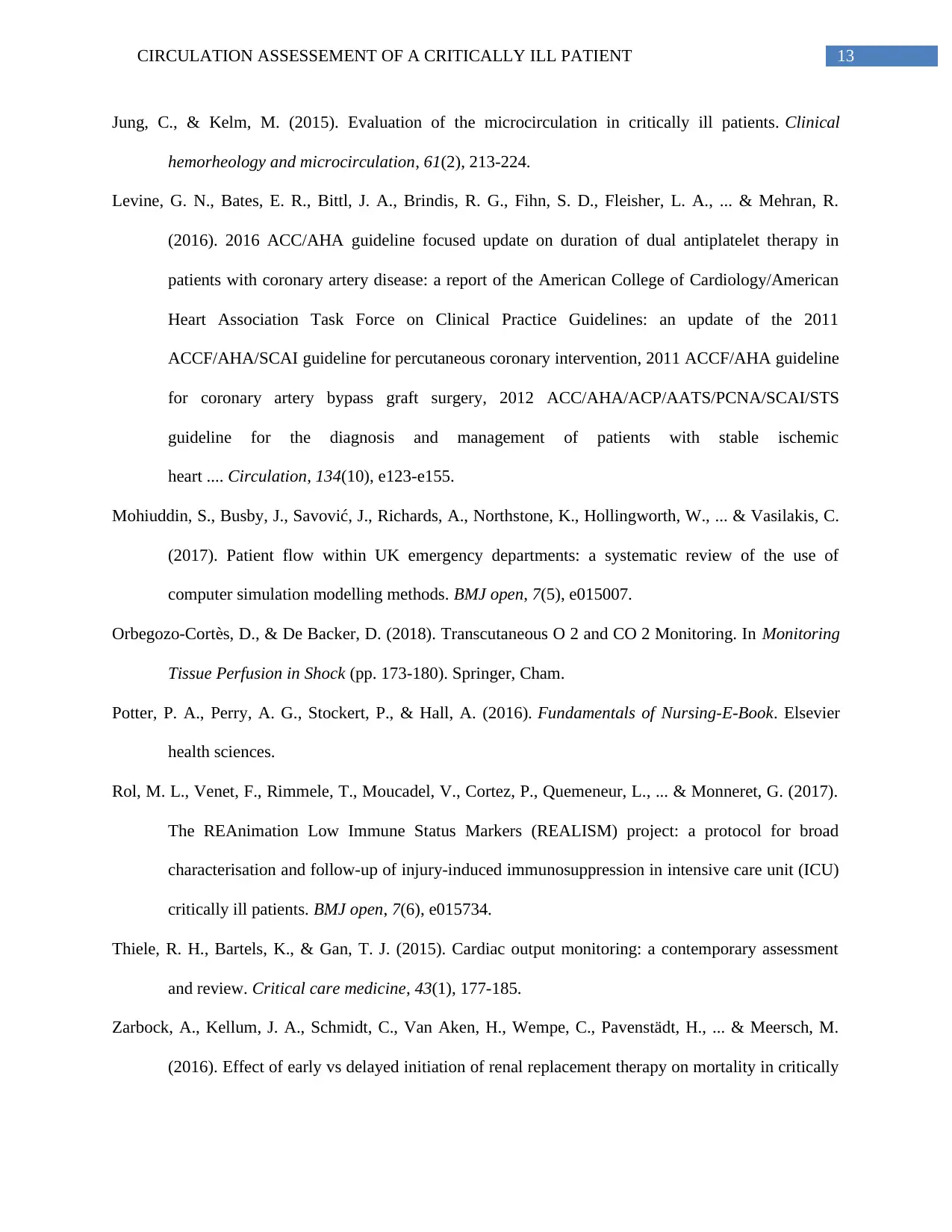
13CIRCULATION ASSESSEMENT OF A CRITICALLY ILL PATIENT
Jung, C., & Kelm, M. (2015). Evaluation of the microcirculation in critically ill patients. Clinical
hemorheology and microcirculation, 61(2), 213-224.
Levine, G. N., Bates, E. R., Bittl, J. A., Brindis, R. G., Fihn, S. D., Fleisher, L. A., ... & Mehran, R.
(2016). 2016 ACC/AHA guideline focused update on duration of dual antiplatelet therapy in
patients with coronary artery disease: a report of the American College of Cardiology/American
Heart Association Task Force on Clinical Practice Guidelines: an update of the 2011
ACCF/AHA/SCAI guideline for percutaneous coronary intervention, 2011 ACCF/AHA guideline
for coronary artery bypass graft surgery, 2012 ACC/AHA/ACP/AATS/PCNA/SCAI/STS
guideline for the diagnosis and management of patients with stable ischemic
heart .... Circulation, 134(10), e123-e155.
Mohiuddin, S., Busby, J., Savović, J., Richards, A., Northstone, K., Hollingworth, W., ... & Vasilakis, C.
(2017). Patient flow within UK emergency departments: a systematic review of the use of
computer simulation modelling methods. BMJ open, 7(5), e015007.
Orbegozo-Cortès, D., & De Backer, D. (2018). Transcutaneous O 2 and CO 2 Monitoring. In Monitoring
Tissue Perfusion in Shock (pp. 173-180). Springer, Cham.
Potter, P. A., Perry, A. G., Stockert, P., & Hall, A. (2016). Fundamentals of Nursing-E-Book. Elsevier
health sciences.
Rol, M. L., Venet, F., Rimmele, T., Moucadel, V., Cortez, P., Quemeneur, L., ... & Monneret, G. (2017).
The REAnimation Low Immune Status Markers (REALISM) project: a protocol for broad
characterisation and follow-up of injury-induced immunosuppression in intensive care unit (ICU)
critically ill patients. BMJ open, 7(6), e015734.
Thiele, R. H., Bartels, K., & Gan, T. J. (2015). Cardiac output monitoring: a contemporary assessment
and review. Critical care medicine, 43(1), 177-185.
Zarbock, A., Kellum, J. A., Schmidt, C., Van Aken, H., Wempe, C., Pavenstädt, H., ... & Meersch, M.
(2016). Effect of early vs delayed initiation of renal replacement therapy on mortality in critically
Jung, C., & Kelm, M. (2015). Evaluation of the microcirculation in critically ill patients. Clinical
hemorheology and microcirculation, 61(2), 213-224.
Levine, G. N., Bates, E. R., Bittl, J. A., Brindis, R. G., Fihn, S. D., Fleisher, L. A., ... & Mehran, R.
(2016). 2016 ACC/AHA guideline focused update on duration of dual antiplatelet therapy in
patients with coronary artery disease: a report of the American College of Cardiology/American
Heart Association Task Force on Clinical Practice Guidelines: an update of the 2011
ACCF/AHA/SCAI guideline for percutaneous coronary intervention, 2011 ACCF/AHA guideline
for coronary artery bypass graft surgery, 2012 ACC/AHA/ACP/AATS/PCNA/SCAI/STS
guideline for the diagnosis and management of patients with stable ischemic
heart .... Circulation, 134(10), e123-e155.
Mohiuddin, S., Busby, J., Savović, J., Richards, A., Northstone, K., Hollingworth, W., ... & Vasilakis, C.
(2017). Patient flow within UK emergency departments: a systematic review of the use of
computer simulation modelling methods. BMJ open, 7(5), e015007.
Orbegozo-Cortès, D., & De Backer, D. (2018). Transcutaneous O 2 and CO 2 Monitoring. In Monitoring
Tissue Perfusion in Shock (pp. 173-180). Springer, Cham.
Potter, P. A., Perry, A. G., Stockert, P., & Hall, A. (2016). Fundamentals of Nursing-E-Book. Elsevier
health sciences.
Rol, M. L., Venet, F., Rimmele, T., Moucadel, V., Cortez, P., Quemeneur, L., ... & Monneret, G. (2017).
The REAnimation Low Immune Status Markers (REALISM) project: a protocol for broad
characterisation and follow-up of injury-induced immunosuppression in intensive care unit (ICU)
critically ill patients. BMJ open, 7(6), e015734.
Thiele, R. H., Bartels, K., & Gan, T. J. (2015). Cardiac output monitoring: a contemporary assessment
and review. Critical care medicine, 43(1), 177-185.
Zarbock, A., Kellum, J. A., Schmidt, C., Van Aken, H., Wempe, C., Pavenstädt, H., ... & Meersch, M.
(2016). Effect of early vs delayed initiation of renal replacement therapy on mortality in critically
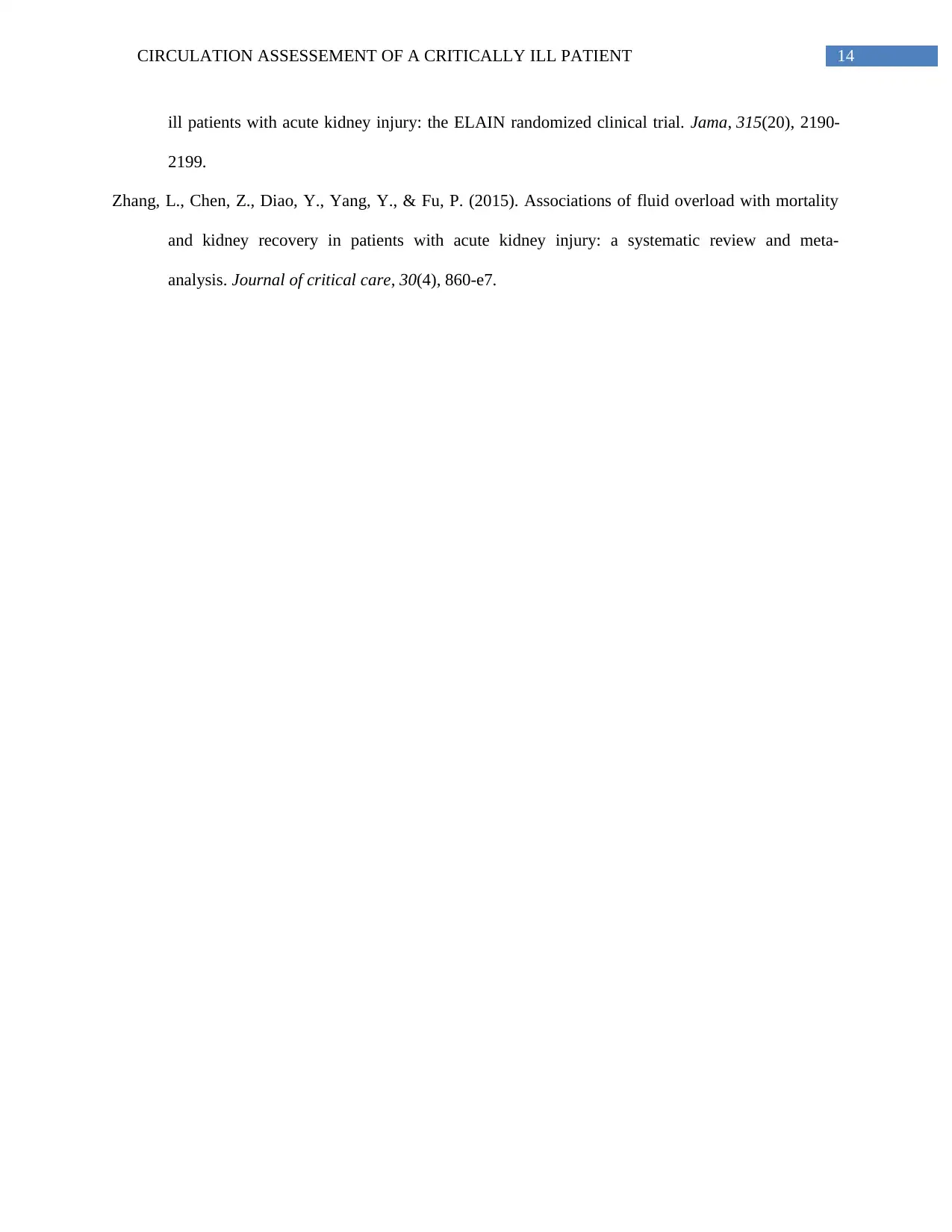
14CIRCULATION ASSESSEMENT OF A CRITICALLY ILL PATIENT
ill patients with acute kidney injury: the ELAIN randomized clinical trial. Jama, 315(20), 2190-
2199.
Zhang, L., Chen, Z., Diao, Y., Yang, Y., & Fu, P. (2015). Associations of fluid overload with mortality
and kidney recovery in patients with acute kidney injury: a systematic review and meta-
analysis. Journal of critical care, 30(4), 860-e7.
ill patients with acute kidney injury: the ELAIN randomized clinical trial. Jama, 315(20), 2190-
2199.
Zhang, L., Chen, Z., Diao, Y., Yang, Y., & Fu, P. (2015). Associations of fluid overload with mortality
and kidney recovery in patients with acute kidney injury: a systematic review and meta-
analysis. Journal of critical care, 30(4), 860-e7.
1 out of 15
Related Documents
Your All-in-One AI-Powered Toolkit for Academic Success.
+13062052269
info@desklib.com
Available 24*7 on WhatsApp / Email
![[object Object]](/_next/static/media/star-bottom.7253800d.svg)
Unlock your academic potential
© 2024 | Zucol Services PVT LTD | All rights reserved.





